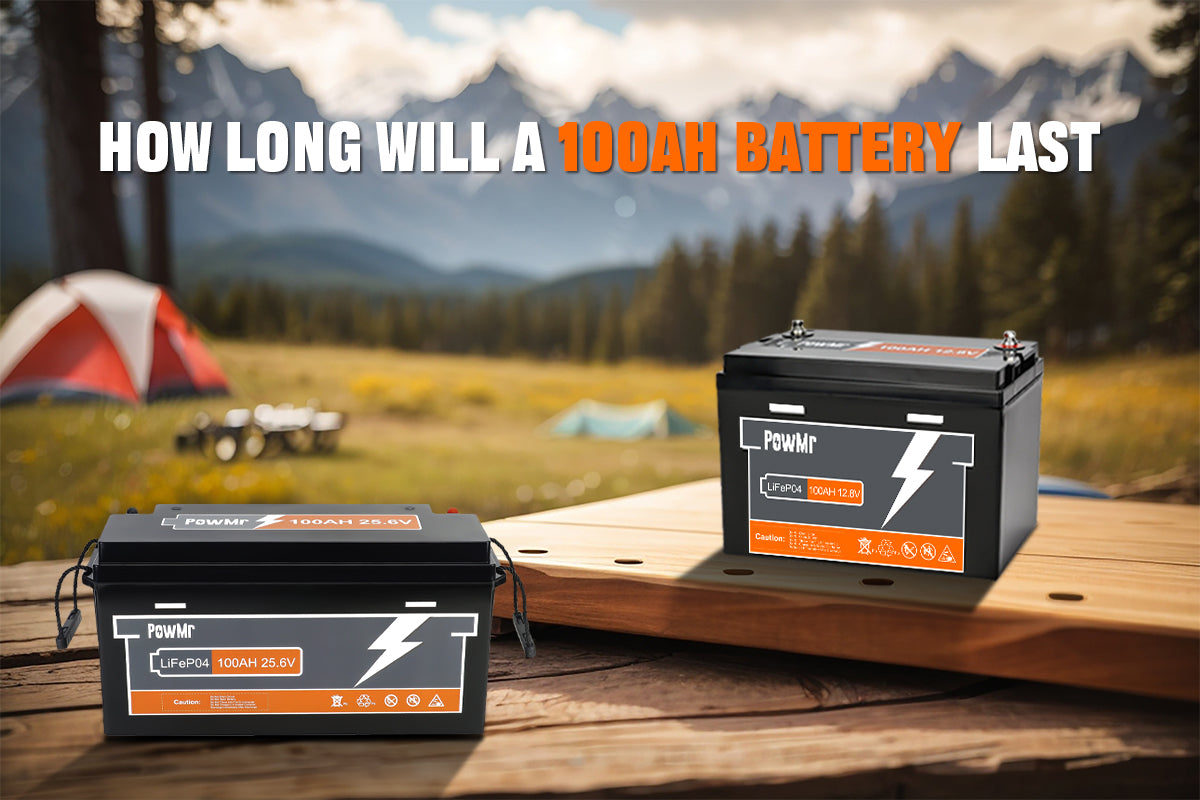When planning for backup power or off-grid energy solutions, knowing how long a battery will last is crucial. A 200Ah (amp-hour) battery is a common choice for many applications, including solar power systems, RVs, and backup power for homes. To accurately determine how long a 200Ah battery will last, several factors must be considered.
In this article, we break down the calculation of how long a 200Ah battery will last into three simple steps, provide a battery backup time calculator, and conclude with insights on 5 key factors that impact battery runtime.
How to calculate how long will a 200Ah battery last
To determine how long a 200Ah battery will last, you need to follow a structured approach that takes into account the energy consumption, battery's capacity, voltage and depth of discharge. Here's a breakdown of the steps.
Step1 - Calculate how many wh in a 200Ah battery
To calculate the total energy storage capacity of a 200Ah battery, multiply the battery's amp-hour (Ah) rating by its voltage. The formula is:
Total energy (Wh) = Battery capacity (Ah) × Battery voltage (V)
This gives you the total energy that the battery can store when fully charged.
For instance, a 12V 200Ah battery would provide 2400Wh, a 24V 200Ah battery would provide 4800Wh, and a 48V 200Ah battery would give 9600Wh.
To optimize battery health, consider the Depth of Discharge (DoD), which represents the usable percentage of the battery’s capacity. Multiply the total energy by the DoD to calculate the usable energy.
Usable energy (Wh) = Battery capacity (Ah) × Battery voltage (V) × Depth of Discharge (DoD)
Step2 - Plan what you will run off a 200Ah battery
The wattage of the appliances you plan to run on a 200Ah battery determines the energy they will draw from the battery, which in turn affects the battery's runtime.
For example, in ideal conditions, a 12V 200Ah battery powering a 100W TV will last 12 hours. Similarly, a 24V 200Ah battery powering a 400W fridge or a 48V 200Ah battery with an 800W load will also last 12 hours, assuming optimal conditions.
However, in reality, you would use the battery to power multiple devices, such as lights, TVs, fridges, laptops, or air conditioners. Once you know the wattage of each device, add them together to determine the total energy consumption.
Step 3 - Figure Out the Battery Backup Time
Finally, to estimate how long the battery will last, divide the total energy capacity of the battery by the total energy consumption of your devices. This calculation gives you the approximate backup time in hours.
Battery Run Time = (Battery Capacity x Battery Voltage x Depth of Discharge) / Total Wattage of the Appliances
We can estimate a battery's runtime either by assuming the inverter operates at full rated power or by adding up the power consumption of all connected devices.
Estimated Runtime of a 200Ah Battery
Below, we list the estimated runtime of a 200Ah battery at 12v/24/48v for common inverter power ratings.
| Battery Capacity | 1000W Load | 2000W Load | 3000W Load |
|---|---|---|---|
| 12V 200Ah | 1 hour 55 minutes | 57.6 minutes | 38.4 minutes |
| 24V 200Ah | 3 hours 50 minutes | 1 hour 55 minutes | 1 hour 17 minutes |
| 48V 200Ah | 7 hours 40 minutes | 3 hours 50 minutes | 2 hours 33 minutes |
A 12V 200Ah battery is best suited for low-power applications. It can power a 1000W device for 1 hour 55 minutes, but a 3000W load will drain it in just 38.4 minutes.
A 24V 200Ah battery provides twice the energy capacity, offering 3 hours 50 minutes of backup for a 1000W load and 1 hour 17 minutes for 3000W.
A 48V 200Ah battery has the highest capacity, running a 1000W load for 7 hours 40 minutes, making it ideal for high-power applications.
200Ah Battery run time calculator
Battery Run Time Calculator
Note:
No inverter is 100% efficient, as some energy is inevitably lost during the conversion process. Higher efficiency means less energy is wasted, leading to longer battery runtime. To more accurately estimate backup time, you can multiply the calculated battery capacity in watt-hours (Wh) by the inverter's efficiency.
Five factors for calculating battery run time
Before the explanation on how long will a 200Ah battery run, it’s necessary to clear one thing up: There is no way to calculate the running time of battery precisely, because it is influenced by many factors.
However, we can consider 5 key factors to estimate the running time as accurately as possible for optimal battery use.
Battery voltage
The voltage in a battery refers to the potential difference between the positive and negative terminals of the battery. But the battery voltage will gradually decrease as the power passes, so we just can use the nominal voltage of the battery(12v, 24v, 36v,48v) to estimate the battery run time.
Battery capacity
Battery capacity, measured in amp-hours (Ah), is obvious from the name, it is Current x Time. According to Charge Conservation, Ah can be interpreted as the amount of charge for charging and discharging in a lithium battery during a certain period of time. A 200Ah battery, theoretically, can deliver 200amps of current for one hour or 20 amps for 10 hours.
Typically, battery capacity is indicated by both voltage and ampere-hours, such as 12V 200Ah or 12V 100Ah.
To better compare energy storage and consumption, it's practical to convert Ah to kWh, as this standardized unit helps in evaluating different energy sources or storage systems. For example, in energy capacity (Wh), a 12V 200Ah battery is equal to two 12V 100Ah batteries connected in parallel, no matter the pair of battery are connected in series or parallel.
Depth of discharge
Depth of discharge(DoD) is the ratio of the power released from the battery to the rated capacity of the battery.
Usually, the battery with the depth of discharge from 10% to 80% is called shallow cycle discharge battery, and another with the 80% depth of discharge is deep cycle battery.
Generally, it’s recommended to keep lead-acid batteries under 50% DoD, while lithium batteries can handle 80-90%. Avoid 100% DoD frequently to maximize battery life and efficiency.
Related Article:
Energy consumption
Energy consumption is the amount of power that your devices use, typically measured in watts (W). To calculate battery runtime, you need to know the total energy consumption of all devices that will be powered by the battery. This includes everything from lights and appliances to electronic devices. Knowing the total wattage of the devices will run is necessary for an accurate calculation.
Efficiency of the inverter
The efficiency of the inverter, expressed as a percentage, indicates how much energy it converts from the battery's DC power into the AC power needed by most appliances. No inverter is 100% efficient; some energy is always lost in the conversion process. Higher efficiency means less energy is wasted, resulting in longer battery runtime.



